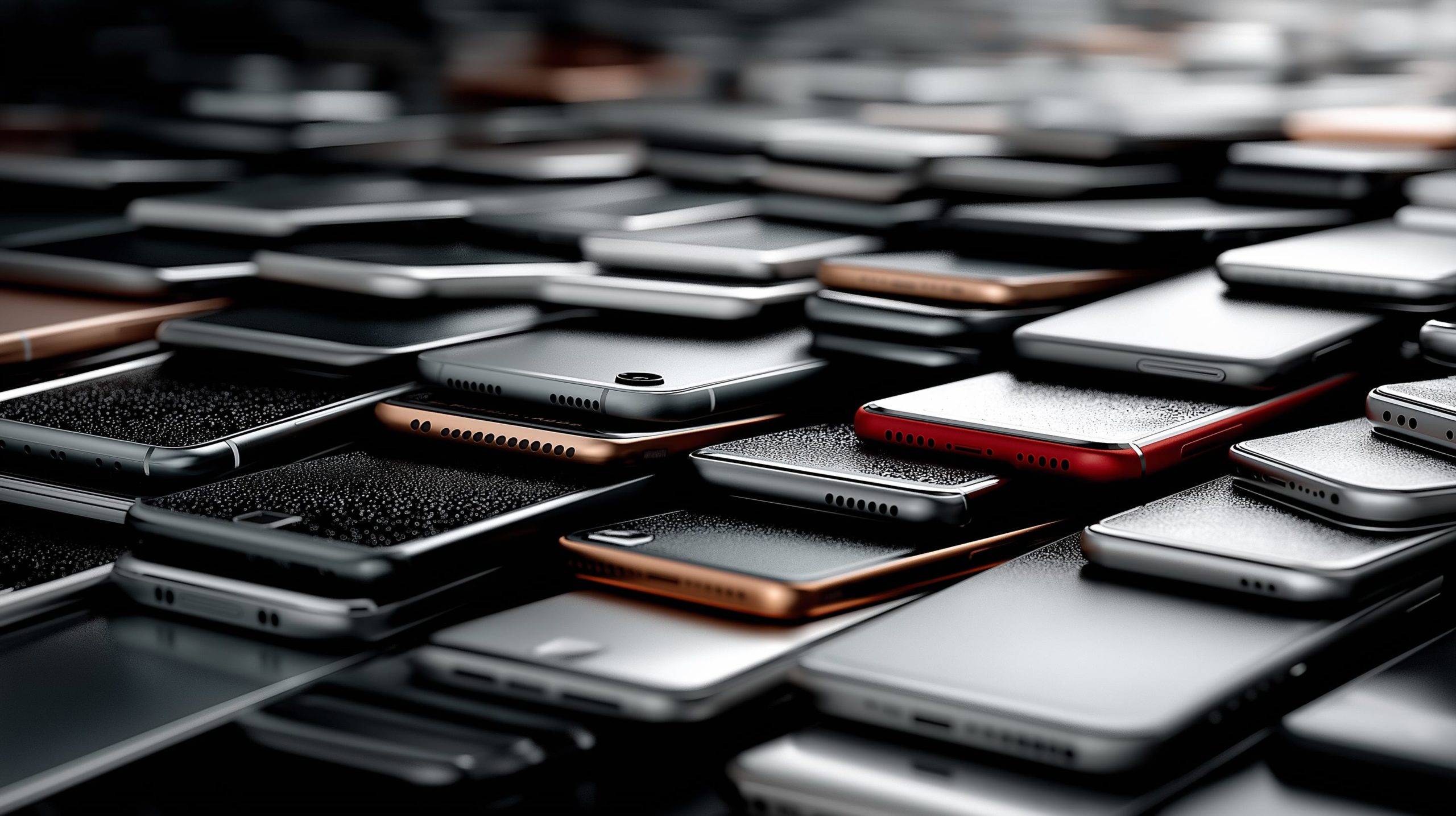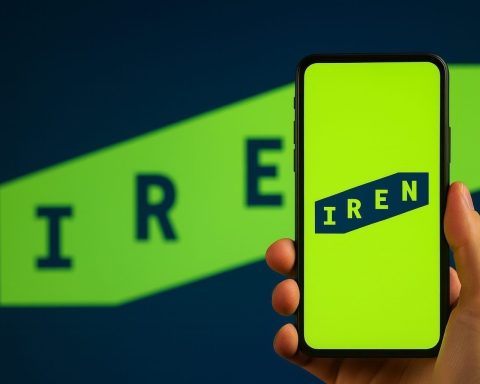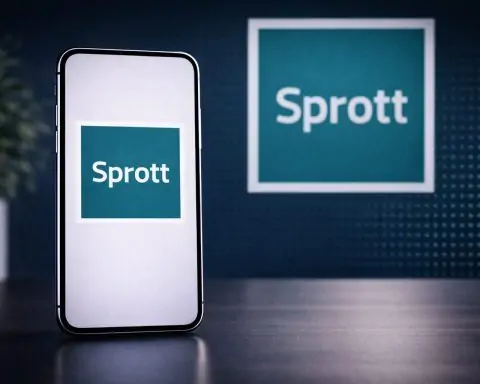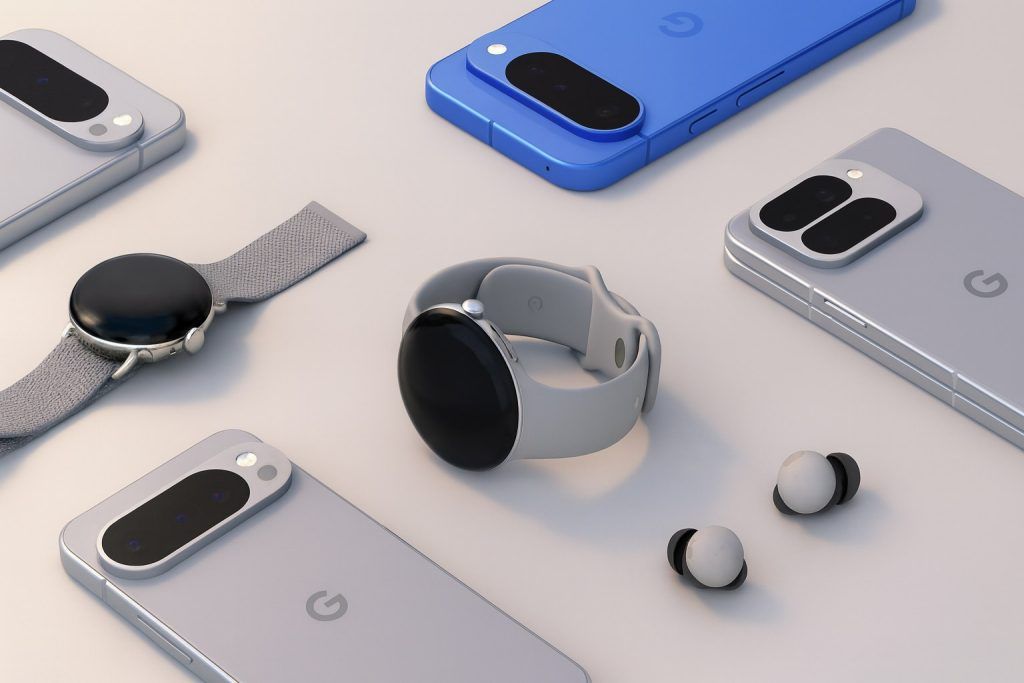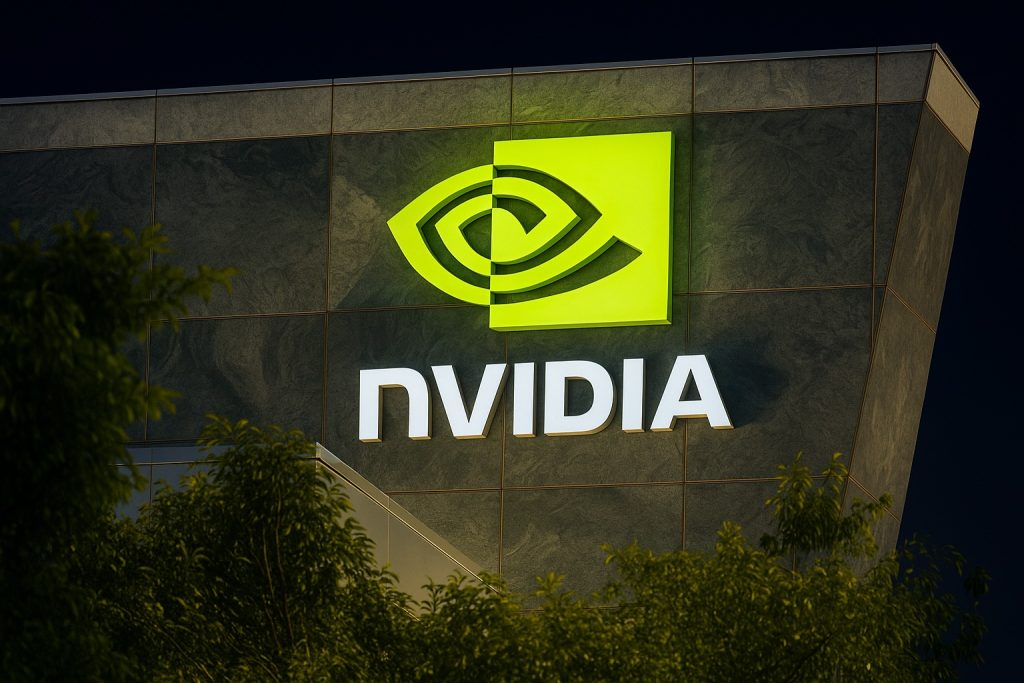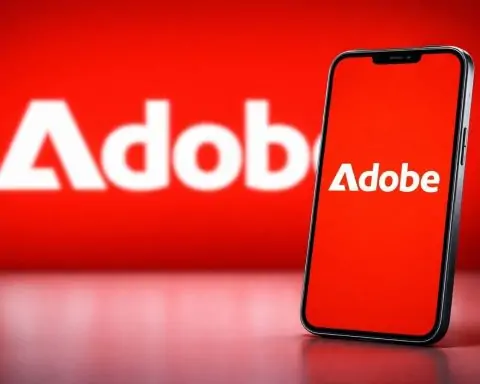- The Pixel 10 lineup was unveiled on August 20, 2025 at Google’s Made by Google event in New York, introducing Pixel 10, 10 Pro, 10 Pro XL, and 10 Pro Fold powered by the Tensor G5.
- The Pixel 10 starts at $799, while the Pixel 10 Pro Fold is priced at $1,799.
- Samsung’s Galaxy Z Fold 7 is billed as the thinnest foldable at 8.9 mm when folded, powered by a Galaxy-customized Snapdragon 8 Elite and featuring a 200 MP main camera.
- Samsung’s Galaxy Z Flip 7 gained a larger cover screen and runs One UI 8 with new AI features.
- Xiaomi’s Redmi Note 15 Pro+ launched on August 21, 2025 with a 7,000 mAh battery, 90W fast charging, a 6.83-inch display at 3,200 nits peak brightness, IP69K rating, and a glass-fiber back.
- Satellite connectivity becomes a smartphone feature, with Google Pixel 10 series supporting emergency SOS and two-way location sharing via Skylo, and with T-Mobile launching the “T-Satellite” service for off-network messaging via SpaceX’s Starlink.
- Leaks point to the iPhone 17 offering a 6.3-inch 120 Hz display and a 24 MP front camera, with rumors of an ultra-thin iPhone 17 Air around 5.5 mm thick.
- Samsung Galaxy S25 FE is expected to launch in Q4 2025 with a 6.4-inch OLED display, 50 MP main camera, an Exynos 2400 variant, and a 512 GB storage option.
- Qualcomm announced the Snapdragon 7s Gen 4 on August 19, 2025, a 4 nm AI-focused mid-range SoC delivering about 7% CPU/GPU gains and supporting up to 2900×1300 at 144 Hz.
- Huawei unveiled HarmonyOS 6 (beta) and Harmony Intelligence at its August 2025 Developer Conference, with the Mate 80 slated to ship HarmonyOS 6 in October.
August 2025 was packed with smartphone news, from flagship launches to future device leaks and game-changing tech trends. Major brands unveiled their latest phones – and teased what’s next – while industry experts weighed in on where mobile tech is headed. Below is a comprehensive roundup of all the big smartphone announcements, rumors, and innovations from August 2025, complete with expert commentary and source links for each development.
Major Launches & Announcements
- Google Pixel 10 Series – AI-Centric Upgrades: Google held its Made by Google event in New York on August 20, introducing the Pixel 10 lineup (Pixel 10, 10 Pro, 10 Pro XL, and 10 Pro Fold) [1]. The focus was on AI integration over flashy hardware changes [2] [3]. Google’s hardware refinements were modest – the phones’ exteriors and displays stayed similar to last year – but the Pixel 10 does add a telephoto camera lens (giving even the base model a triple-lens setup) [4] [5]. All models run on Google’s new Tensor G5 chip and introduced “Pixelsnap” magnetic wireless charging accessories (Google’s take on MagSafe) [6]. Pricing stayed flat: the Pixel 10 starts at $799, while the Pixel 10 Pro Fold (2nd-gen foldable) is $1,799 [7]. Google put heavy emphasis on software smarts – e.g. an AI “photo coach” in the camera and a proactive assistant that surfaces info without prompts [8]. “We’ve got the best models, we’ve got the best AI assistant… it’s not about just the hardware anymore,” said Google’s hardware chief Rick Osterloh during the event [9] [10], underscoring the shift toward AI-driven features.
- Samsung Galaxy Z Fold 7 & Flip 7 – Refined Foldables: Samsung’s Galaxy Unpacked (held in late July) rolled into August news with the retail debut of its latest foldable phones. The Galaxy Z Fold 7 was touted as Samsung’s thinnest and lightest foldable yet (just 8.9 mm folded) [11]. It packs flagship power (a Snapdragon 8 Elite chip customized for Galaxy) and, for the first time in a Samsung foldable, a 200 MP main camera sensor [12] [13]. Samsung refined the design with a slimmer hinge and larger displays – the Fold 7’s unfolded screen is more immersive, while the Galaxy Z Flip 7 got a bigger cover screen for improved usability [14]. Both devices also introduced One UI 8 software with new AI features. The Fold 7 launched at $1,999 (a $100 increase from last year) [15], while the pocketable Flip 7 remained more affordable and trendy (analysts noted flip-style foldables are gaining popularity because “it’s cheaper and has captured the imagination” of users seeking something different [16]). Samsung’s foldables garnered positive attention for polishing the foldable concept with “slimmer designs and bigger screens” that represent the next generation of the format [17].
- Xiaomi’s Redmi Note 15 Pro+ – Big Battery & Bright Screen: Xiaomi expanded its popular midrange lineup in China with the Redmi Note 15 Pro+, officially launched on August 21. This phone turned heads by offering specs normally seen in flagships: a gigantic 7,000 mAh battery (supporting 90W fast charging) and a 6.83-inch display with 3,200 nits peak brightness – one of the brightest smartphone screens ever [18] [19]. It even features IP69K ruggedness (high dust/water resistance, unusual for a midrange device) and premium touches like a glass-fiber back [20] [21]. Xiaomi’s teasers highlighted these upgrades as a leap over last year’s model. Powered by a new Qualcomm chip (see Chipset section), the Redmi Note 15 Pro+ shows how Chinese brands are pushing the envelope in battery life and display tech for value-priced phones.
- Other Releases:Google’s Pixel Watch 4 and Pixel Buds 2A also debuted alongside the Pixel 10 phones, bringing a brighter display and better battery life to the Watch, and new AI-powered audio features to the earbuds [22] [23]. While August is quiet for Apple launches (Apple’s iPhone event happens in September), Apple did release iOS 19 beta updates (preparing for the fall iPhone launch) and we saw new color variants and minor phone releases from some OEMs. Motorola, OPPO/Vivo, and others had no major global launches this month, but Sony did ship its Xperia 1 VII (launched earlier in May) to markets, continuing to target niche photography enthusiasts [24]. Overall, the biggest splash in August came from Google’s and Samsung’s events, and a flurry of mid-tier phones in Asia.
Leaks & Rumors that Made Headlines
- Apple iPhone 17 & “iPhone Air” Leaks: Even without an August Apple event, the rumor mill was in overdrive for the upcoming iPhone 17 series (expected September 2025). Multiple leaks pointed to a significant design refresh. For one, the standard iPhone 17 is rumored to jump to a 6.3-inch display with 120 Hz refresh – finally bringing high refresh rate to non-Pro iPhones [25]. All iPhone 17 models will reportedly see camera improvements (e.g. a 24 MP front camera) and come in new colors like purple and green [26]. More dramatically, Apple is said to be readying an ultra-thin “iPhone 17 Air” – “the slimmest phone ever” at about 5.5 mm thick – which could replace the current Plus model [27] [28]. Leaked design schematics suggest even the Pro models might get a new rear-camera layout (with the triple lenses arranged in a unified rectangular bar) and possibly a switch back to lighter aluminum sides instead of titanium [29] [30]. Apple hasn’t confirmed anything, but an inadvertent leak of an Apple event invite via the Apple TV app tipped September 9, 2025 as the iPhone 17 launch date. Hype is building that this could be Apple’s most striking update in years – one analyst noted Apple is exploring bold designs like foldables and ultra-thin phones because “the smartphone has become… a boring category” and needs a jolt of excitement [31].
- Samsung Galaxy S25 FE – Fan Edition Returns: Samsung’s budget-friendly “FE” series is apparently making a comeback in late 2025. Leaks of the Galaxy S25 FE (Fan Edition) in mid-August revealed detailed specs and even official-looking images of multiple color options [32]. The S25 FE is expected to feature a 6.4-inch OLED, 50 MP main camera, and intriguingly, a return to Samsung’s in-house Exynos chipset (the leaked specs mention an Exynos 2400 variant) [33]. If true, Samsung would be reintroducing Exynos chips in a mainstream phone after leaning on Qualcomm for recent flagships. The leaks also suggest a competitive price and even a 512 GB storage option [34]. Samsung hasn’t officially announced the S25 FE yet, but multiple reports indicate it could launch in Q4 2025 as a value alternative to the flagship Galaxy S25 series.
- Foldable iPhone & Other Buzz: Speculation around a future foldable iPhone gained traction after a J.P. Morgan report surfaced. The report predicts Apple will debut a foldable iPhone in 2026 (likely a flip-style or fold-out tablet design) priced around $1,999 [35]. While this is beyond this year, it underscores that Apple is seriously assessing foldables – potentially entering a market of ~19 million foldable units by 2025 [36]. Industry experts like CCS Insight’s Ben Wood aren’t surprised: “Apple is rarely first… it likes to take its time,” he said, noting Apple let Samsung work out early kinks (like fragile foldable screens) before jumping in [37]. In other leaks, OnePlus 15 rumors began swirling (with an October 2025 China launch expected for the next OnePlus flagship) [38], and Google Pixel 10a whispers started (suggesting Google might release a budget Pixel in 2026 given it skipped a Pixel 9a). Lastly, Huawei’s Mate 80 series was tipped for Q4 2025 launch with the new HarmonyOS 6 – important since Huawei’s phones don’t use Android (see OS section) [39]. While leaks should be taken with skepticism, August’s chatter gave consumers plenty to look forward to in the coming months.
Mobile Chipsets and OS Developments
- Qualcomm’s Mid-Range Chip Refresh: On August 19, Qualcomm announced the Snapdragon 7s Gen 4 processor, an AI-focused mid-range SoC aimed at upper-mid-tier phones [40]. This new 7-series chip is only a modest upgrade – built on the same 4 nm process and CPU architecture as its predecessor – yielding roughly a 7% boost in CPU and GPU performance [41] [42]. The slight gains come from a higher-clocked Cortex-A720 core, while the overall 1+3+4 core layout and efficiency cores remain unchanged [43]. Qualcomm did add support for ultra-wide displays (up to 2900×1300 @ 144 Hz), hinting at use in gaming phones or devices with unconventional screen sizes [44]. Notably, this chip will power Xiaomi’s Redmi Note 15 Pro+ and similar devices [45]. The incremental upgrade suggests Qualcomm is holding its big architecture moves (like integrating its custom “Oryon” CPU cores) for the next flagship Snapdragon 8 series. Indeed, enthusiasts are already looking ahead – the Snapdragon 8 Gen 5 (and “8 Elite 2”) are expected to be unveiled at Qualcomm’s summit in late 2025 [46]. In the meantime, Qualcomm’s flagship Snapdragon 8 Gen 4/8 Elite (Gen 4), which powers phones like Samsung’s Galaxy S25 and Fold 7, continued to lead on performance.
- MediaTek’s AI-Powered Push: Taiwan-based MediaTek has been aggressively iterating on its flagship Dimensity chips. Earlier in 2025, it launched the Dimensity 9400+, an enhanced 5G SoC that puts a big focus on on-device AI and power efficiency [47]. MediaTek touted support for the latest large language models (LLMs) running locally on the phone, enabling faster “agentic AI” functions and personal AI assistants without the cloud [48] [49]. The 9400+ also packed a beefier 12-core GPU and added support for China’s BeiDou satellite system and improved dual-SIM 5G connectivity [50]. This chip began appearing in Chinese flagship phones over the summer, such as the Oppo Find X8 Pro and Vivo X200 Pro – which reviewers praised for rivaling Qualcomm’s performance [51]. MediaTek’s strategy of dominating the mid-range and emerging premium segment paid off: by mid-2025, MediaTek surpassed Qualcomm in global smartphone chipset market share [52]. Thanks to strength in affordable and mid-tier devices (especially in markets like India), MediaTek is now the volume leader, even as Qualcomm retains the high-end crown [53].
- Apple’s Silicon and Modem Moves: While Apple’s next A-series mobile chip (likely A19 Bionic) will be revealed with the iPhone 17 in September, there was interesting news on Apple’s silicon strategy via Qualcomm’s earnings. Qualcomm executives confirmed that Apple has begun phasing in its own 5G modems – the iPhone 16e, a model launched earlier in 2025, was the first iPhone to use an Apple-designed modem instead of Qualcomm’s [54]. Apple’s in-house modem project has been long in the works, and this development suggests Apple is testing it in a variant before a wider rollout. Qualcomm warned that Apple’s eventual shift to fully in-house modems will significantly reduce Qualcomm’s revenue from 2026 onward [55]. In the meantime, Apple’s forthcoming A19 chip is expected to leverage 3 nm process improvements (as the A18 did) and focus on efficiency and camera ISP upgrades. Additionally, Apple’s iOS 19 (the new iPhone operating system) was in beta throughout August. iOS 19 is set to bring features like Live Voicemail transcription, improved AirPods integration with “Live Translate,” and even built-in RCS messaging encryption for the first time [56] [57]. Apple was fine-tuning these features in developer betas, with a final release due in September alongside new hardware.
- Android & HarmonyOS Updates: Google’s Android 16 also approached final release in August 2025. Pixel 10 phones shipped with Android 16 out of the box, and Google pushed out the last beta/QPR (quarterly platform release) updates for older Pixels [58]. Android 16’s headline improvements include privacy enhancements, better migration tools, and deeper AI-powered features (tying in with Google’s Gemini AI). Meanwhile, Huawei – still blocked from Google’s ecosystem – doubled down on its own OS. At Huawei’s Developer Conference in China, the company unveiled HarmonyOS 6 (beta) and its new Harmony Intelligence multi-agent framework [59]. HarmonyOS 6 brings an improved UI and an AI assistant (“Xiaoyi”) coordinating tasks across apps [60]. It’s slated to roll out in October on Huawei’s Mate 80 flagship, as Huawei seeks to build a viable alternative to Android [61]. Huawei’s consumer chief Richard Yu even claimed in an interview that “HarmonyOS will reach the level of Android and iOS by the end of 2025,” arguing that starting fresh allows it to be “more advanced, lighter, and… use new technologies” without legacy constraints [62] [63]. While third-party analysts are skeptical HarmonyOS can truly rival Android/iOS globally, Huawei is making strides in China’s market with millions of devices now on Harmony and a growing app ecosystem.
Trend Watch: Foldables, Satellite Connectivity, AI and More
Foldable Phones Go Mainstream (Slowly)
Foldable smartphones were a hot trend in August 2025, with multiple launches and improvements, yet they remain a niche portion of the market. Samsung’s Galaxy Z Fold 7 and Flip 7 exemplify the refinement of foldables – they’re slimmer, more durable (the Fold 7 even has IP68 dust/water resistance, a first for a foldable) [64], and sport more powerful cameras than prior generations. Google jumped in too: the Pixel 10 Pro Fold debuted as Google’s second-gen foldable, featuring a slightly larger 6.4-inch outer screen (thinner bezels) and dust resistance as well [65]. Chinese OEMs also continued their foldable forays: Xiaomi’s Mix Fold series and Honor’s Magic V line saw strong competition in China, with Honor Magic V2 and others pushing ultra-thin designs under 10mm. Global sales of foldables are growing but still modest – about 1.5% of smartphones in 2025 (roughly 18–19 million units) [66]. Analysts note that foldable adoption was actually down slightly in early 2025, perhaps due to high prices and minor year-over-year upgrades [67]. The flip-style form factor (like Samsung’s Z Flip) is currently more popular than tablet-style folds, likely because it’s more compact and affordable [68]. Still, the consensus is that foldables represent a “next generation” of mobile design that could reinvigorate consumer excitement [69]. Industry experts expect Apple’s eventual entry to legitimize foldables further. In the meantime, manufacturers are iterating to improve durability (new hinge designs to reduce screen creases), battery life, and app optimization for larger screens. Foldables are here to stay, but the race is on to make them cheaper and tougher to truly hit the mainstream.
Satellite Connectivity Becomes a Smartphone Feature
What started with emergency SOS signals on a mountaintop is evolving into satellite messaging for everyday users. In August, Google announced that the Pixel 10 series supports satellite-based communications, expanding on the feature it introduced with Pixel 9 [70]. Google is working with satellite service provider Skylo to enable emergency SOS and even two-way location sharing via satellites on Pixel phones running Android 16 [71]. At launch, Pixel 9/10 users in regions like the U.S., Canada, Europe, and Australia can use satellites to reach emergency services or share their location off-grid [72] [73]. Furthermore, T-Mobile rolled out its new “T-Satellite” service (in partnership with SpaceX’s Starlink network), and Pixel 10 owners on T-Mobile get early access to off-network messaging features [74]. This means certain apps like Google Messages and Maps can send basic texts or location data without any cellular coverage by bouncing signals off satellites [75]. Apple, which was first to introduce Emergency SOS via satellite on the iPhone 14 in 2022, expanded its satellite feature to more countries (it’s now in dozens of regions on iPhone 14/15). However, Apple still limits it to emergency use. The industry is clearly trending toward integrating satellite comms for consumer devices – providing peace of mind and basic connectivity where cell towers don’t reach. By 2025’s end and into 2026, we expect more Android devices (e.g. Samsung’s Galaxy S25) to include satellite messaging support [76]. While satellite texting is very slow (and supports only low-bandwidth data), it’s a major step for safety and communication in remote areas. The ultimate vision is that satellite capability becomes as standard as GPS in smartphones, enabling truly global coverage for critical connectivity.
AI Features Everywhere
Artificial intelligence was the buzzword of the year, and in August it became clear that smartphones are doubling as AI platforms. Google’s Pixel 10 launch underscored this: many new features are powered by on-device AI and Google’s Gemini model. For example, Pixel’s camera app now includes an AI “photo coach” that gives you tips for better composition and automatically suggests the best shots [77]. Pixels also have an AI Call Assistant that can, for instance, detect when you’re dialing an airline and proactively pull up your flight info (contextual help without being asked) [78]. Google even demoed live language translation for phone calls – essentially using AI to translate conversations in real time on the device [79]. Qualcomm and MediaTek, as noted, are optimizing chips for generative AI tasks: the newest MediaTek Dimensity chips support running large language models and AI assistants on-device [80], and Qualcomm’s AI Engine is present even in mid-range SoCs. We’re seeing practical AI perks like enhanced voice assistants, on-device transcription, smarter spam call filtering, and AI-curated photo albums across Android and iOS. Another trendy AI-powered feature is “personal voice” cloning for accessibility (Apple’s iOS 17/18 introduced that, and it’s likely more refined in iOS 19). Camera AI is also big: many 2025 phones use AI algorithms for things like Magic Eraser object removal, night mode fusion, and creating bokeh effects or AI-generated backgrounds. Industry-wide, the perspective has shifted such that “it’s not about just the hardware anymore” – the smarts are the selling point [81]. That said, experts caution not to fall for hype: “a lot of [AI] stuff [companies] showed would run just as well on last year’s hardware” [82], meaning the key is the software innovation. But with AI functionality becoming ubiquitous, smartphones are increasingly pocket AI assistants, not just communication devices.
Camera Innovation Continues
Smartphone cameras saw incremental yet important innovations in August. The specs war is still on – Samsung’s new Fold 7 adopting a 200 MP camera (using the same sensor as its Galaxy S25 Ultra) was a headline-grabber [83]. This ultra-high resolution allows more detail and better low-light pixel binning; Samsung claims the Fold 7’s main cam produces 4× more detail and 44% brighter images than its predecessor [84]. Zoom lenses remain a hot commodity: Apple’s iPhone 15 Pro Max (2023) introduced a 5× periscope zoom, and leaks suggest the iPhone 17 Pro/Max will further refine telephoto capabilities – though perhaps focusing on better image stabilization and sensors rather than higher magnification. Variable optical zoom lenses (which Sony and a few others have tried) are rumored for upcoming flagships too. On the front camera side, Apple might bump to a 24 MP selfie camera [85], and other brands are using AI to enable features like 3D face unlock and portrait video on front shooters. Notably, almost every new phone now leverages AI post-processing heavily: for example, Google’s Pixels use Tensor’s AI to unblur faces or upscale digital zoom, and Xiaomi touted AI scene optimization in its Redmi Note series. We’re also seeing exotic ideas: August leaks showed concepts of under-display cameras improving (to make truly full-screen phones), and even discussion of “liquid lens” technology for faster focus (Xiaomi has experimented in past). While those didn’t materialize in products this month, they hint at future directions. The practical trend for 2025 is that flagship phones are closing the gap with dedicated cameras, prompting professional outlets like DXOMark to rank phones like the Vivo X200 Ultra and iPhone in league with DSLRs for casual use. In summary, August’s smartphone crop reinforced that camera capability is still a key battleground – whether it’s bigger sensors, more lenses (even base models now commonly have triple cameras [86]), or smarter software that makes photography point-and-shoot simple.
Industry Commentary & Market Outlook
August 2025’s developments prompted analysts and experts to offer perspective on the smartphone industry’s trajectory. A clear theme was that the market is mature and saturated, pushing companies to innovate in design and features to spark consumer interest. “Smartphones have become somewhat of a boring category – absolutely essential… but no longer the next big thing,” observes CCS Insight’s Ben Wood, explaining why manufacturers are exploring radical ideas like foldables and ultra-thin phones [87]. This sentiment was echoed in sales data: after several years of decline, the global smartphone market flattened in Q2 2025 – IDC recorded just ~1% year-over-year shipment growth, while Canalys actually saw a slight decline [88]. Economic uncertainty (inflation, tariffs) has made consumers hold onto phones longer, especially at the low end [89]. “Reduced demand for lower-end smartphones, where price sensitivity is highest,” is dragging on growth, notes IDC’s research director Nabila Popal, who also cited a dip in China’s market [90]. On the bright side, premium devices are still selling: Apple saw modest growth thanks to demand in emerging markets [91], and Samsung’s sales were buoyed by its mid-range Galaxy A series [92]. The top five brands (Samsung, Apple, Xiaomi, Oppo/Vivo, Transsion) now command the lion’s share of the market, squeezing smaller players especially in markets like the U.S. [93] [94]. This consolidation means competition is fierce among the giants – hence the marketing blitz around AI features, foldables, and ecosystem perks to lock in users.
Experts also weighed in on specific strategies: Google’s Pixel strategy, for example, earned both praise and skepticism. Carolina Milanesi of Creative Strategies noted that after last year’s big hardware redesign, this year “feels more like a big push from a marketing perspective” by Google [95]. The Pixel 10’s mainstream appeal attempt (with celebrities at the launch and expansion to more countries) is Google’s bid to grow beyond its niche 1% market share [96]. However, Pixel’s impact remains small – one analyst wryly noted that much of Pixel’s new AI functionality “would probably run almost exactly the same on last year’s hardware”, underscoring that Google is really selling an ecosystem and vision [97]. Meanwhile, Samsung is doubling down on foldables as a differentiator, but it too faces challenges: after an initial buzz, foldable sales in 2024 were flatlining [98]. Samsung hopes the significantly improved Fold/Flip 7 can reverse that trend [99].
Looking ahead, industry watchers believe fall 2025 will be pivotal. Apple’s iPhone 17 launch in September will test how much innovation is left in the slab-phone form factor (if the leaks of larger 120Hz screens and an “iPhone Air” hold true). Any pricing moves will be closely watched – some rumors hint Apple might tweak prices, and Samsung raised the Fold 7 price slightly to counter component costs [100]. Component suppliers (like Qualcomm) are adapting too: Qualcomm’s reliance on selling chips for $800+ phones is risky in a slowing market, and indeed Qualcomm’s stock dipped as it forecast essentially flat phone sales and the eventual loss of Apple’s modem business [101] [102]. One notable insight from Counterpoint Research is that MediaTek’s strength in mid-range phones has made it the top chipset vendor by volume [103], reflecting a shift as developing markets play a bigger role in smartphone growth.
Finally, there’s a sense that new categories adjacent to smartphones are on the horizon – from wearables and AR glasses to AI assistants – but the phone remains the central hub. As Ben Wood put it, the smartphone is ubiquitous and indispensable, yet to excite consumers, companies must offer something novel or different (be it a foldable design, a nostalgia-inducing flip, or a jaw-droppingly thin device) [104] [105]. The consensus among experts: the smartphone industry in 2025 is a “mature but evolving” space – unit growth is slow, but technology within the phones is leaping forward (AI, satellite links, new form factors) [106]. All these August developments set the stage for a highly anticipated fall product cycle. As the month ended, tech enthusiasts braced for September launches, hopeful that the innovations teased and trended in August – from AI wizards in our pockets to ever more versatile cameras – would deliver an exciting new chapter in mobile computing.
Sources: The Verge, Reuters, TechCrunch, Android Authority, GSMArena, et al.:
- Google Pixel 10 launch and features [107] [108] [109]
- Samsung Galaxy Z Fold/Flip 7 details [110] [111]
- Xiaomi Redmi Note 15 Pro+ specs [112] [113]
- Apple iPhone 17 and Air rumors [114] [115]
- Samsung Galaxy S25 FE leak [116]
- Qualcomm Snapdragon 7s Gen 4 announcement [117] [118]
- MediaTek market share and Dimensity 9400+ [119] [120]
- Huawei HarmonyOS 6 and claims [121] [122]
- Foldable market analysis (Guardian) [123] [124]
- Satellite connectivity – Pixel 10 & T-Mobile [125] [126]
- Expert commentary on market (Guardian, LightReading) [127] [128]
References
1. www.reuters.com, 2. www.reuters.com, 3. www.reuters.com, 4. www.reuters.com, 5. www.theverge.com, 6. www.reuters.com, 7. www.reuters.com, 8. www.reuters.com, 9. www.reuters.com, 10. www.reuters.com, 11. www.phonearena.com, 12. www.phonearena.com, 13. www.phonearena.com, 14. www.theguardian.com, 15. www.phonearena.com, 16. www.theguardian.com, 17. www.theguardian.com, 18. www.notebookcheck.net, 19. www.notebookcheck.net, 20. www.notebookcheck.net, 21. www.notebookcheck.net, 22. www.theverge.com, 23. www.theverge.com, 24. www.phonearena.com, 25. techcrunch.com, 26. techcrunch.com, 27. techcrunch.com, 28. techcrunch.com, 29. techcrunch.com, 30. techcrunch.com, 31. www.theguardian.com, 32. tech.yahoo.com, 33. www.sammobile.com, 34. www.sammyfans.com, 35. www.theguardian.com, 36. www.theguardian.com, 37. www.theguardian.com, 38. www.phonearena.com, 39. technode.com, 40. 9to5google.com, 41. 9to5google.com, 42. 9to5google.com, 43. 9to5google.com, 44. 9to5google.com, 45. www.notebookcheck.net, 46. 9to5google.com, 47. www.mobileworldlive.com, 48. www.mobileworldlive.com, 49. www.mobileworldlive.com, 50. www.mobileworldlive.com, 51. www.androidcentral.com, 52. www.reuters.com, 53. www.reuters.com, 54. www.reuters.com, 55. www.reuters.com, 56. www.macrumors.com, 57. www.reddit.com, 58. 9to5google.com, 59. technode.com, 60. technode.com, 61. technode.com, 62. www.huaweicentral.com, 63. www.huaweicentral.com, 64. www.theverge.com, 65. www.theverge.com, 66. www.theguardian.com, 67. www.counterpointresearch.com, 68. www.theguardian.com, 69. www.theguardian.com, 70. www.satellitetoday.com, 71. www.satellitetoday.com, 72. www.satellitetoday.com, 73. www.satellitetoday.com, 74. www.satellitetoday.com, 75. www.satellitetoday.com, 76. www.techlicious.com, 77. www.reuters.com, 78. www.reuters.com, 79. www.reuters.com, 80. www.mobileworldlive.com, 81. www.reuters.com, 82. www.reuters.com, 83. www.phonearena.com, 84. www.phonearena.com, 85. techcrunch.com, 86. www.theverge.com, 87. www.theguardian.com, 88. www.lightreading.com, 89. www.lightreading.com, 90. www.lightreading.com, 91. www.lightreading.com, 92. www.lightreading.com, 93. www.lightreading.com, 94. www.lightreading.com, 95. www.reuters.com, 96. www.reuters.com, 97. www.reuters.com, 98. www.theguardian.com, 99. www.theguardian.com, 100. www.phonearena.com, 101. www.reuters.com, 102. www.reuters.com, 103. www.reuters.com, 104. www.theguardian.com, 105. www.theguardian.com, 106. ts2.tech, 107. www.reuters.com, 108. www.reuters.com, 109. www.reuters.com, 110. www.phonearena.com, 111. www.phonearena.com, 112. www.notebookcheck.net, 113. www.notebookcheck.net, 114. techcrunch.com, 115. techcrunch.com, 116. www.sammobile.com, 117. 9to5google.com, 118. 9to5google.com, 119. www.reuters.com, 120. www.mobileworldlive.com, 121. technode.com, 122. www.huaweicentral.com, 123. www.theguardian.com, 124. www.theguardian.com, 125. www.satellitetoday.com, 126. www.satellitetoday.com, 127. www.theguardian.com, 128. www.lightreading.com
